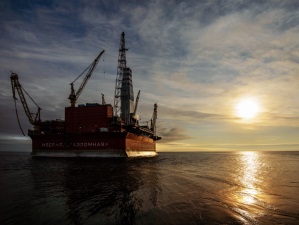The company has begun geological and geophysical analysis of currently available information in order to construct a geological model of the region, to identify the most promising structures within these blocks, and to develop a programme for further exploration and prospecting activities.
The Severo-Zapadniy block is located in the Pechora Sea, relatively close to Gazprom Neft’s other Arctic-Shelf assets, the Dolginskoye and Prirazlomnoye fields. The sea around this block extends to a depth of approximately 200 metres. A total 11,500 kilometres of 2D seismic operations have thus far been undertaken on the block, with data obtained to a depth of 1.17 linear kilometres for each square kilometre surveyed. The block is 8,860 square kilometres in extent, with D1 reserves (Russian classification) estimated at more than 105 million tonnes of oil and gas condensate, together with 60 billion cubic metres of gas.
The Heysovskiy block is located in the northern part of the Barents Sea, west of the Novaya Zemlya archipelago, about 1,000 kilometres from the mainland. The block is 83,600 square kilometres in extent, with the sea surrounding it extending to depths of between 200 and 500 metres. The region is characterised by extreme environmental and climatic conditions — the north—west and north—east of the block can remain ice-bound throughout the year, although in certain years the sea does break through. Data on the block is currently limited, with only 8,300 kilometres of 2D seismic having been conducted to date, with data obtained to a depth of 0.1 linear kilometres for each square kilometre surveyed. While commercial oil and gas reserves are, as yet, unproven, the volume of D2 reserves (Russian classification) is estimated at 140 million tonnes of oil and gas condensate, as well as two trillion cubic metres of gas.
Gazprom Neft CEO Alexander Dyukov commented: “The Arctic remains a strategic priority for our company. Thus far, Arctic territory has remained under-researched, although we are, step by step, progressing further every year. Gazprom Neft has continued geological prospecting at the Dolginskoye field throughout 2014, with the first new ‘Arctic oil (ARCO)’ being shipped from the Prirazlomnoye field, Pechora Sea, in April. The experience we have gained in developing these assets will allow us — safely and effectively — to open up the natural resources hidden in the Russian Arctic.”
Gazpromneft Sakhalin holds the licences to the Dolginskoye field (located in the Pechora Sea) and the Severo-Vrangelevskoye field (covering the East Siberian and Chukchi seas). A fourth exploration well was drilled at the Dolginskoye field in 2014, allowing geophysical and hydrodynamic (well) testing operations to be carried out — the first time that such a major volume of work has been completed at a well during this region’s short ice-free season. Geological prospecting at the field is set to continue. A prospecting programme at the Vrangelevskoye field is currently being developed.
A further Arctic Shelf project currently under development by Gazprom Neft is the Prirazlomnoye field, located on the Pechora Sea shelf, 60 kilometres from the Varandey settlement. The Prirazlomnoye project is the first ever exploration and production project on the Russian Arctic Shelf, with production commencing in December 2013 and the first tanker transporting new “Arctic Oil (ARCO)” being despatched from the field in April 2014. Development of the field has demanded the design and construction of the high-technology “Prirazlomnaya” rig, designed to withstand the harsh environment and climatic conditions while ensuring complete environmental safety in oil extraction.
Об экологии месторождений
Команда электрического цеха ЛуТЭКа стала победителем туристического слета-2014
Первые лица Тюменской области посетили Няганскую ГРЭС ОАО «Фортум»
ЛуТЭК включается в волонтерское движение


